What is Budding?
- Budding can define as a type of asexual reproduction mostly seen in Yeast and Hydra etc.
- In this process, a small outgrowth or bulge is formed on parent body.
- That bud gradually increase in size and then, after sometime, it separates to make new individual.
- Sometimes the bud stay attached and make chain-like colonies, mostly in Hydra (Cnidaria).
- In Yeast (Saccharomyces cerevisiae) the bud is develop from parent cell due to uneven cell division, cytoplasm divides unequal.
- Nucleus divides by mitosis, one nucleus goes into small bud and rest stay in mother cell.
- After that, the wall is formed between two, so new one become independent.
- Budding occurs also in some plants, and even some animals when special tissues grow abnormally fast.
- This method helps for rapid multiplication, though variation is very less, so population remain almost same genetically.
- Sometimes energy waste is low so it’s quite efficient kind of reproduction / multiplication.
Definition of Budding
Budding is a form of asexual reproduction in which a new organism develops from an outgrowth or “bud” on the parent organism, eventually detaching to live independently.
Types of Budding
I. Types of Biological Budding (Asexual Reproduction)
- External Budding – In this type, the bud form on outer side of parent body. The small outgrowth grow till maturity, then it breaks off to make a new body.
- The process is mostly visible on surface, so sometimes called Exogenous Budding.
- Bud can be symmetrical or not. For example in Saccharomyces cerevisiae (Yeast) the division is asymmetrical; while in Hydra it show more equal formation.
- This process helps in quick multiplication, though not much variation happen between offsprings.
- Internal Budding – Here the bud develop inside the parent body, sometimes called Endogenous Budding.
- The internal part (sometimes called gemmule) consist of many cells closed in thick wall. When condition become good, it grow into new individual.
- Seen in freshwater sponges like Spongilla and Sycon.
- Also seen in parasite like Toxoplasma gondii where two daughter cell form inside mother cell and then eat the mother body before separation — that’s called endodyogeny, interestingly.
II. Types of Horticultural Budding (Plant Grafting Techniques)
- T–Budding / Shield Budding – A T–shape cut made on bark of rootstock, the single bud (scion) insert inside it. This need bark to be slipping. Common in roses, oranges, plums, peaches.
- Inverted T–Bud / I–Bud – Same method but the “T” shape is upside down, used also when bark is loose.
- Chip Budding – Used when bark not slipping, a chip with bud from scion placed in similar cut of rootstock. Used for grapes and others.
- Patch Budding – A patch of bark with bud is inserted in matching window of rootstock. Seen in mango, citrus, rubber, walnut etc.
- Ring or Annular Budding – Involves bud with ring of bark fitted on rootstock; used for Cinchona plants.
- Flute Budding / Forkert Budding – Bud inserted under flap of bark lifted from rootstock, so look like flute shape.
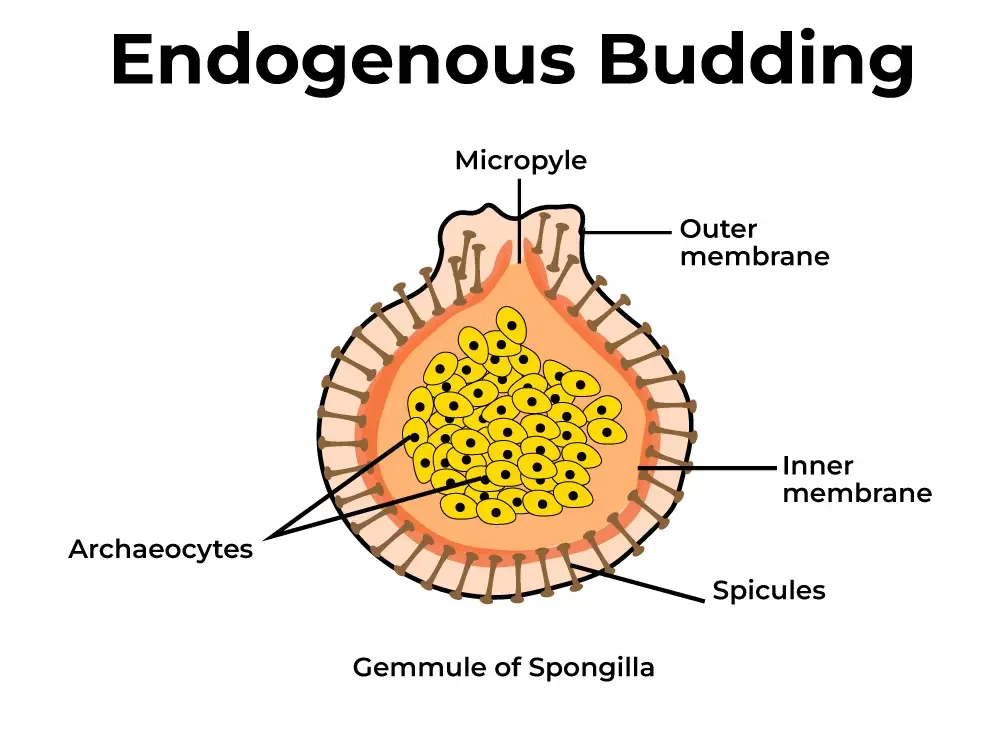
1. Budding in Plants
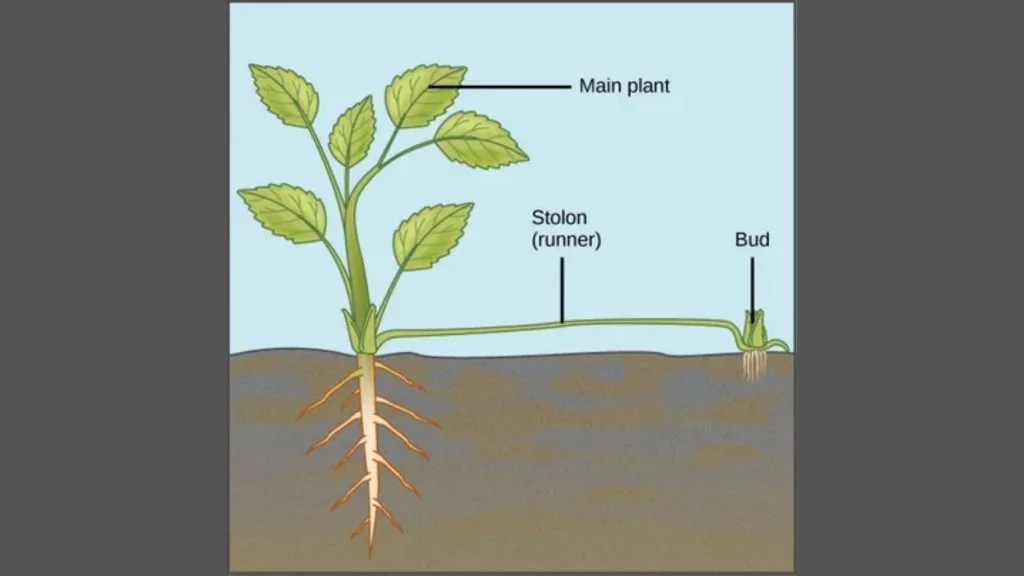
- Budding in plants can define as both a horticultural method and a natural asexual process.
- In horticulture / propagation field, budding is a type of grafting, where a single bud (called scion) is inserted into bark of another plant called rootstock.
- The aim – to merge good characters of both, like strong roots from stock and tasty fruits from scion.
- For success the cambium layers of both sides must align and stay tight / moist, otherwise union fails.
- Budding usually done during growing season, though in some species during winter when they are dormant.
- Protection from drying and contamination are always needed, buds are covered with tapes or wax etc.
Types of Budding in Plants–
- T-Budding (Shield-Budding) – Bud placed in a T-shaped incision when bark is “slipping”. Used for apples, peaches, roses etc.
- Chip Budding – Does not need slipping bark; a chip with bud is cut and fitted into a matching cut. Common for grapes.
- Patch Budding – Patch of bark with bud fixed onto another bark patch; used in citrus / mango / rubber.
- Ring (Annular) Budding – Ring of bark including bud transferred to stock.
- Flute (Forkert) Budding – Bud pushed under bark flap lifted from stock, then tied firmly.
Such techniques mostly used for fruit trees, ornamentals, and sometimes nut trees, to keep same cultivar traits.
Natural budding also refers as asexual reproduction in some plants. New buds grow from older body parts – roots, stems, or leaves.
Example – Solanum tuberosum (potato) has “eyes”, which are small buds that grow into new plants when conditions good.
Another context is flower bud formation in fruit crops, where vegetative meristems change to reproductive ones.
This process passes stages – induction, initiation, differentiation, maturation, anthesis.
Hormones like auxin, GA (gibberellin), and ethylene, plus temperature / day length, affect how buds turn to flowers.
So overall, in any context, a bud means a tiny structure that can grow into a new part – either a shoot, a flower, or even a full new plant.
Advantages of Budding in Plants
- Budding method is preferred because large number of plants can propagated from one parent quickly.
- The new plant keeps same characters of parent variety, so fruits or flowers remain true-to-type.
- It is cheaper / less time taking than full grafting since only a single bud is needed not a big scion piece.
- The healing between bud and rootstock happens faster because the cut area is very small.
- When cambium contact good, success rate become higher, even with delicate species like Citrus.
- Compatibility issues are reduced as only small tissue used, this sometimes prevail rejection problems.
- Plants produced by budding start flowering and fruiting earlier, which make it useful for commercial growers.
- Old / damaged trees can be rejuvenated by inserting fresh bud on healthy part, giving them new and fresh life.
- Easier to handle – one person can do many buds per day, and no need of complex tools or setup.
- In some cases, resistant rootstock used, so new bud gains better disease and drought tolerance, etc.
- Uniform orchard can be maintained since all trees become genetically same and growth rate similar.
- For ornamental plants, budding allows mixing of different colors or forms on one rootstock making decorative results.
Disadvantages of Budding in Plants
- Budding can not be done successfully in all plants; it needs specific species compatibility between scion and stock.
- When cambium layers do not align well, the union fails, and bud dries before healing.
- Process is delicate, so it must be done by skilled person, otherwise damage occurs easily.
- Success depends on weather condition, mostly during growing season; in too cold or hot time buds not take well.
- If proper care not given, infection or drying of bud happens fast.
- Rootstock and scion must be about same diameter; difference in size cause poor contact.
- Sometimes only few buds available on mother plant, so number of new plants produced limited.
- Budding requires frequent monitoring; if wrapping too tight or too loose, the bud may die.
- Not suitable for plants having thick bark or latex (like Hevea brasiliensis) which hinder union.
- The new plant may inherit rootstock weaknesses, like sensitivity to soil conditions or diseases.
- Cost becomes higher when skilled labour needed for large-scale operations.
- In windy or dry regions, failure rate rise because buds get detached before healing properly.
2. Budding in Hydra
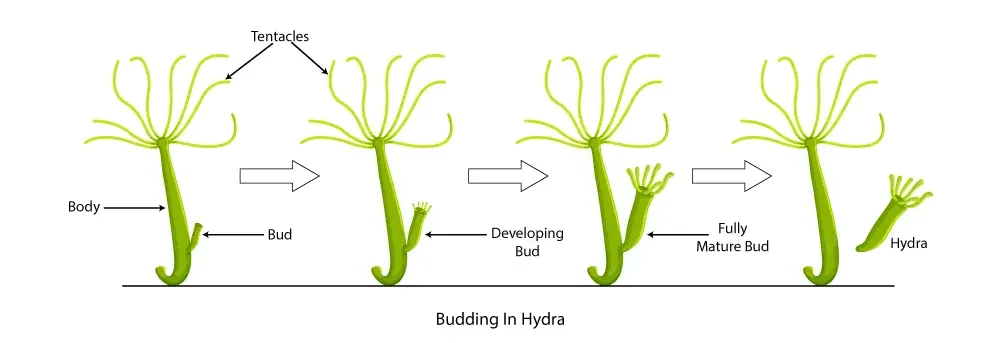
- Hydra is a small fresh-water animal that belong to phylum Cnidaria, often used as model for asexual reproduction studies.
- The budding in Hydra can define as a process where a new individual grows out from the parent’s body wall.
- It starts when some regenerative cells at a particular region begin to divide rapidly by mitosis.
- These repeated cell divisions create a tiny outgrowth or bud on the surface of parent organism.
- The bud remains attached to the parent for some time, getting its nutrition and support from it.
- Gradually, the small bud shows tentacles and mouth opening, looking almost like miniature Hydra.
- As the bud grow further, it becomes able to capture food and perform simple movements on its own.
- After full development, the new Hydra detaches from parent body, drifting away to live independently.
- The process happens on the outer body surface, so it termed as External or Exogenous Budding.
- This kind of budding is symmetrical, meaning the new organism forms evenly on one side.
- Offspring formed by this method are genetically identical to parent since no gametes involved.
- Under favorable conditions, many buds may appear at once on one parent, making colony-like look for short time.
- When environment turns harsh, the frequency of budding reduces or stops until better conditions return.
- Budding in Hydra mainly occur by External (Exogenous) Budding.
- In this type, a small outgrowth develops on the outer body wall of parent.
- The process starts when interstitial cells or regenerative cells begin to divide rapidly at one point.
- The newly formed bud remain attached to parent for some time and receive food and oxygen from it.
- After complete growth – with tentacles and mouth – it detaches to become an independent organism.
- This type is symmetrical, means the bud grows evenly and looks same on both sides.
- Some literature also mention a very rare Internal (Endogenous) Budding in certain conditions, where buds may form inside body cavity, but it not common for Hydra.
- Mostly, External Budding is the regular method, considered the typical reproductive mode of Hydra.
- Since this process involve no gametes, the offspring remain identical (clones) of the parent.
Steps Involved in Hydra Budding
- The process of budding in Hydra start when few epidermal cells begin to divide repeatedly at one point on body wall.
- This area bulges outward slowly forming a small bud or projection, visible under simple microscope.
- Inside the bud, cells continue dividing, and basic body layers – ectoderm and endoderm – start developing.
- A gastrovascular cavity (like a simple stomach) is formed inside the new bud by inward folding of tissue.
- As the bud enlarges, small tentacle buds appear at the free end, followed by a mouth opening formation.
- During this time, the bud stays attached to the parent, sharing nutrients and water.
- When it becomes mature enough to feed by itself, the connection between bud and parent gets thinner.
- Finally, the new Hydra detaches or breaks off from parent and begins independent life in water.
- Sometimes multiple buds form at same time, so few remain attached even when others already free.
- The complete process usually finish within few days depending on temperature and food availability.
Types of budding in hydra
In Hydra, budding helps both reproduction and regeneration of lost parts.Two main types are seen — Lateral Budding and Basal Budding.
1. Lateral Budding –
- It is the common type found in Hydra.
- A small outgrowth appears on the side wall of parent body.
- The bud grows gradually, forms tentacles and mouth, then later separates to live freely.
- Usually happens when conditions are good, like plenty of food and proper temperature.
2. Basal Budding –
- This type is less common.
- Here, a new bud develops at the base region of parent Hydra.
- Often occurs under stressful situations, e.g. shortage of food or temperature change.
- The bud may help the species survive by producing new individual before parent dies.
Both kinds are forms of asexual reproduction, producing offspring genetically same as parent. Sometimes several lateral buds can appear at once, giving chain-like look to Hydra body.
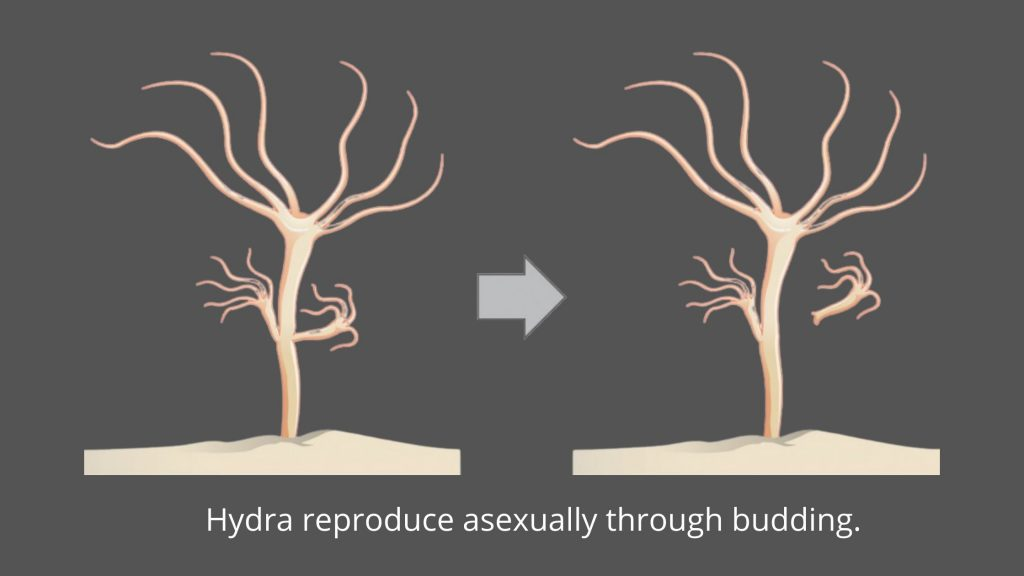
3. Animal budding
- Animal budding can define as a kind of asexual reproduction where new organism grows from a small outgrowth or bud on parent’s body.
- The bud forms because of mitotic cell divisions in specific region, then slowly develops into a full new organism.
- Only one parent takes part, so it’s called monoparental reproduction, and no fertilization needed.
- The new individual stays attached to parent for some time, taking nutrition from it till mature enough.
- After growth, it separates and starts living independently; sometimes it may stay attached forming colonies.
- Offspring produced are genetically identical clones of parent since no mixing of gametes happens.
- Hydra shows external or exogenous budding, where bud appears on outside body wall.
- Some invertebrates like corals, jellyfish polyps, and sea anemones also multiply by this way, helping reef formation.
- In parasites like Toxoplasma gondii, a special form known as internal (endogenous) budding occurs where two daughter cells form inside mother cell and later consume it.
- Sponges like Spongilla or Sycon also form internal buds called gemmules, that help in survival during harsh conditions.
- Main features include – quick multiplication, no gametes, identical offspring, and parent organism remains alive after process.
4. Budding in yeast cell
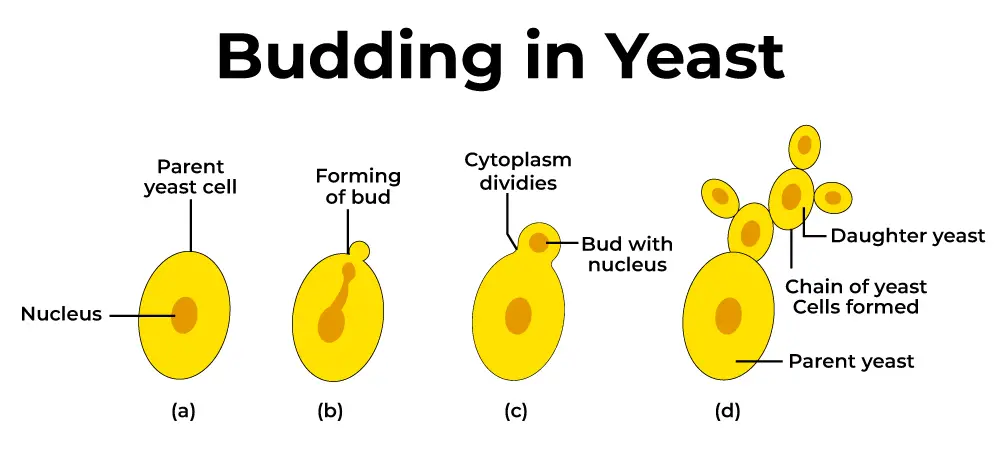
- Budding in yeast is described as an asymmetric, external form of asexual reproduction where a small bud is produced on the mother cell.
- The process is usually triggered when an abundant supply of nutrients is available and cell-cycle regulators allow progression.
- A site for bud emergence is selected on the mother surface, polarity markers are deposited and Cdc42-like polarity is established.
- Localized loosening of the cell wall and directed vesicle delivery lead to a tiny protrusion, the bud primordium, being formed.
- Growth of the bud proceeds by targeted secretion of membrane and wall material along actin cables, so the bud enlarges rapidly.
- DNA replication and mitosis are initiated in the mother, and one of the daughter nuclei is moved into the bud through the bud neck.
- A septin ring is assembled at the mother–bud neck to demarcate the division site and to organize cytokinetic events.
- Cytokinesis is executed by synthesis of a septum (primary septum, rich in glucans/chitin) and coordinated cell-wall remodeling.
- After separation, the mother cell retains a permanent bud scar (chitin-rich), which marks previous budding events.
- The bud is typically smaller than the mother at first, and maturation continues after detachment until normal size reached.
- Budding frequency is influenced by environmental factors (temperature, nutrients) and internal cell-cycle controls, under poor conditions budding is reduced.
- This method allows rapid clonal expansion (many buds can be produced over hours), while the mother cell remains alive and accumulates bud scars.
Process
- Budding in yeast can define as a polarized outgrowth from the mother cell surface that will become the bud.
- A future bud site is selected, depending on strain pattern (axial or bipolar), and polarity landmarks are deposited there.
- Localization of the polarity GTPase Cdc42 is established at the chosen site, and actin cables are oriented toward that site.
- A small protrusion (bud emergence) is formed when the cell wall and plasma membrane are loosened locally, and membrane material is supplied toward the site.
- Polarized growth continues, the bud enlarges by targeted vesicle delivery along actin, and cytoskeleton dynamics are maintained.
- DNA replication is initiated in the mother (S phase) and the nucleus undergoes mitosis, with one set of chromosomes directed toward the bud.
- The septin ring is assembled at the mother–bud neck and a contractile-like structure is formed to coordinate division.
- Cytokinesis is carried out by formation of a primary septum (glucan/chitin-rich) and remodeling of cell wall, leading to cell separation.
- After separation, a permanent bud scar (rich in chitin) is left on the mother cell surface, marking previous budding events.
- The overall timing and frequency of budding are influenced by nutrient availability, temperature, and cell-cycle regulators; under poor conditions budding is reduced, under good conditions it may be frequent.
Advantages of Budding
- In budding, a new organism is formed from small outgrowth, so reproduction happens quickly and with less energy.
- It can occur in both unicellular and multicellular organisms like Hydra, Yeast, etc., making it very common.
- No need for gametes / fertilization – process is simpler and faster ; offspring are mostly same as parent.
- Since parent and bud stay connected for some time, nutrient supply is shared, growth becomes more steady.
- In unfavorable condition, buds can remain attached ; after that when environment improves, they grow – help in survival.
- Method allows rapid colony formation, many buds can grow together forming chain-like structure.
- Damage or loss of parent part is not dangerous – because new buds already developing on it, so species continuity kept safe.
- It is useful in laboratory for clonal propagation, to get many identical organisms faster.
- The process is natural, costless, and doesn’t need any special organs / equipment, that’s why it prevail widely in nature.
Disadvantages of Budding
- Offsprings produced by budding are genetically identical, so no variation occur, which reduce adaptability in changing environment.
- Since all buds are same as parent, if one get disease – whole colony may infected quickly.
- Overcrowding happens around the parent body, as many buds remain attached for longer time causing space problem.
- The new bud sometimes detached early, so it not survive properly due to incomplete development.
- The method mostly limited to some simple organisms like Yeast, Hydra, etc., so it’s not suitable for higher animals or plants.
- Energy and nutrients of parent are divided among growing buds, hence parent growth become weaker / slower.
- Because no gametes involved, evolution rate is very low – species may not cope with environmental stress.
- Sometimes abnormal or deformed buds form, which waste resources and not give viable offspring, a kind of biological loss.
- In long term, this method reduce diversity and makes species more prone to extinction when environment change fastly.
Importance of Budding
- Budding help organisms to reproduce without gametes, so life continuity is maintained even in absence of mating partner.
- It is important for rapid population increase, because many buds can form in short time on one parent.
- Used in laboratories for clonal propagation, helpful in genetic and biochemical studies.
- Many industries use budding organisms like Yeast for fermentation to make bread, alcohol, etc.
- In aquatic organisms like Hydra, this method ensure quick recovery of population after any destruction.
- Important for maintaining genetic stability, since offspring same as parent, good traits remain preserved.
- It support asexual reproduction in simple forms of life, showing how life can continue in easy and energy-saving way.
- Budding also show evolutionary significance, by demonstrating earliest mode of reproduction from which other methods evolved.
- In research, this process is studied to understand cell division, growth pattern, and developmental biology mechanisms.
- Because of its simplicity, it’s often used as model for teaching basic concepts of reproduction and regeneration in schools.
Examples of Budding
- Hydra – small buds develop on the parent body wall, after some time they detach and grow into new organism.
- Yeast – in this unicellular fungus, a small bulge form on parent cell; nucleus divide, one part go into bud which later separate.
- Sponge (Sycon) – produces external buds that remain attached for some time, forming clusters before breaking off.
- Corals – budding occur to form new polyps; these remain attached, helping to build coral reefs.
- Planaria – though mainly shows regeneration, but budding-like process observed during reproduction in some conditions.
- Bacteria – like Hyphomicrobium, reproduce by unequal budding, forming daughter cells smaller than parent.
- Protozoa – some species like Noctiluca shows budding of small reproductive bodies during their life cycle.
- Yeast cells in fermentation – widely used in industries (brewing, baking etc.), so budding here have commercial importance.
- Hydra in freshwater – classic textbook example, showing visible buds under microscope easily for study purpose.
Differences between budding and binary fission
| Criteria | Binary Fission | Budding |
|---|---|---|
| Definition | A form of asexual reproduction where a single mother cell divides into two daughter cells. | A form of asexual reproduction where an offspring arises as a small outgrowth or bud from the parent organism. |
| Mother Cell | No distinct mother cell remains post-division as it splits into two equal daughter cells. | The parent organism remains intact even after the bud detaches, allowing it to produce multiple buds over time. |
| Cytoplasm Division | The division of cytoplasm is symmetrical, resulting in two cells of roughly equal size. | The division of cytoplasm is asymmetrical, with the bud receiving a smaller portion compared to the parent. |
| Occurrence | Predominantly observed in prokaryotic organisms, such as bacteria. | Commonly seen in eukaryotic organisms, including yeast and certain multicellular organisms. |
Differences between budding and fragmentation
| Criteria | Budding | Fragmentation |
|---|---|---|
| Definition | A form of asexual reproduction where offspring arise from a bud-like projection formed on the parent organism. | A form of asexual reproduction where offspring are produced from fragments or pieces of the parent organism. |
| Occurrence | Observed in both unicellular and multicellular organisms. | Predominantly seen in multicellular organisms. |
| Maturation | Buds mature while still attached to the parent and eventually detach to become independent organisms. | Fragments separate from the parent and then mature into new individuals. |
| Number of Offspring | Typically results in the formation of a single offspring from each bud. | Can produce multiple offspring from various fragments of the parent organism. |
| Examples | Yeast, sea anemones, and certain corals. | Planaria, fungi, lichens, and certain starfish species. |
Quiz
What is budding?
a) A form of sexual reproduction.
b) A form of asexual reproduction where offspring arise from a bud-like projection.
c) A form of reproduction involving spores.
d) A form of reproduction involving seeds.
In which of the following organisms does budding primarily occur?
a) Mammals
b) Birds
c) Yeast
d) Fish
During budding, the division of cytoplasm is:
a) Equal
b) Unequal
c) Not involved
d) Random
Which of the following statements about budding is true?
a) It results in genetic diversity.
b) It requires two parent organisms.
c) It can occur in both unicellular and multicellular organisms.
d) It always results in multiple offspring.
In which stage does the bud in budding become an independent organism?
a) Initiation
b) Growth
c) Maturation
d) Detachment
Which organism reproduces by forming a bud-like outgrowth on its body?
a) Amoeba
b) Paramecium
c) Hydra
d) Euglena
The offspring produced through budding are:
a) Genetically different from the parent.
b) Genetically identical to the parent.
c) Half identical to the parent.
d) Completely unrelated to the parent.
Which of the following is NOT an advantage of budding?
a) Rapid production of offspring.
b) Preservation of desirable traits.
c) Genetic diversity.
d) No need for a mating partner.
In budding, the newly formed organism is also known as:
a) Spore
b) Seed
c) Bud
d) Fragment
Which of the following plants reproduce by budding?
a) Ferns
b) Mosses
c) Potato
d) None of the above
FAQ
What is budding?
Budding is a form of asexual reproduction where a new organism develops from an outgrowth or bud on the parent organism. The new organism remains attached to the parent until it matures, after which it detaches and becomes independent.
Is budding exclusive to plants?
No, budding is not exclusive to plants. While it is common in certain plants, it also occurs in some animals, such as hydras and yeast.
How does budding differ from other forms of asexual reproduction?
In budding, the offspring grows out of the body of the parent organism, whereas in other forms of asexual reproduction, the parent organism may divide into two or more parts to produce offspring.
Why is the division of cytoplasm unequal in budding?
In budding, the bud receives only a portion of the parent’s cytoplasm. The parent retains the majority of its cytoplasm, allowing it to continue its normal functions and potentially produce more buds.
Do offspring produced through budding have the same genetic material as the parent?
Yes, offspring produced through budding are genetically identical to the parent organism.
Can a single parent organism produce multiple buds simultaneously?
Yes, depending on the species and environmental conditions, a single parent organism can produce multiple buds at the same time.
What are the advantages of budding as a reproductive strategy?
Budding allows for rapid reproduction, especially under favorable conditions. It also doesn’t require a mating partner, making it efficient for organisms in isolated environments.
Are there any disadvantages to budding?
One major disadvantage is the lack of genetic diversity among the offspring, making the population vulnerable to environmental changes or diseases that affect one individual.
How does budding in yeast work?
In yeast, a bud forms on the surface of the cell. As the bud grows, it receives a copy of the DNA and other cell components. Once the bud is fully developed, it detaches from the parent cell and becomes a new yeast cell.
Can budding occur in multicellular organisms?
Yes, budding can occur in multicellular organisms. For example, hydras, which are simple aquatic animals, reproduce through budding.
- Isaksson H, Conlin PL, Kerr B, Ratcliff WC, Libby E. The consequences of budding versus binary fission on adaptation and aging in primitive multicellularity. MDPI, 2021 12(5):661. DOI: 10.3390/genes1205066
- Jahangeer M, Mahmood Z, Mashooq A, Mehmood R, Munir N, Tahir IM, et a. Yeast cells secondary metabolites and their industrial applications; a review. Pakistan Journal of Medical and Biological Sciences, 2019. 2(1):62-67.
- https://www.researchgate.net/publication/337482316_Yeast_cells_secondary_metabolities_and_their_
- https://eschooltoday.com/learn/buddin/
- https://www.flexiprep.com/Important-Topics/Biology/Budding.html
- https://www.toppr.com/ask/content/concept/budding-201512/
- https://www.khanacademy.org/science/in-in-class-10-biology/in-in-reproduction/in-in-asexual-reproduction-and-its-types/v/budding-fragmentation-regeneration-spores-how-do-organisms-reproduce-biology-khan-academy
- https://www.vedantu.com/question-answer/budding-explain-the-budding-in-hydra-by-the-class-10-biology-cbse-5f72334ba276427534a93770
- https://www.sciencefacts.net/budding.html
- https://www.aakash.ac.in/important-concepts/biology/budding
- https://biologysir.com/budding-in-hydra-yeast-and-spongilla-with-diagram/
- https://eschooltoday.com/learn/buddin/
- https://www.biologyonline.com/dictionary/budding
- https://www.vedantu.com/biology/budding
- https://www.vocabulary.com/dictionary/budding?family=buddings
- https://www.microscopemaster.com/budding.html
- Text Highlighting: Select any text in the post content to highlight it
- Text Annotation: Select text and add comments with annotations
- Comment Management: Edit or delete your own comments
- Highlight Management: Remove your own highlights
How to use: Simply select any text in the post content above, and you'll see annotation options. Login here or create an account to get started.